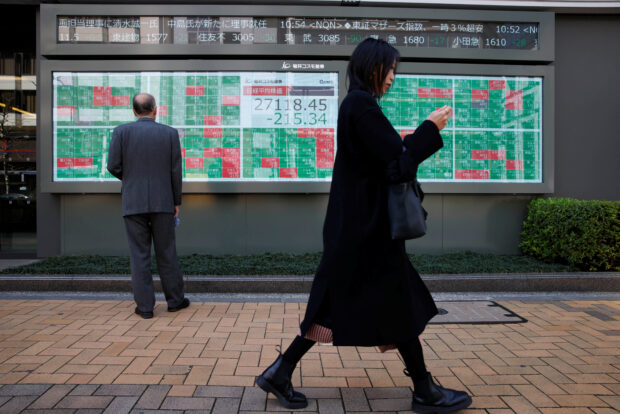Yen’s drop to 1990 low lifts Nikkei; China stocks sag

A woman walks past a man examining an electronic board showing Japan’s Nikkei average and stock quotations outside a brokerage, in Tokyo, Japan, March 20, 2023. REUTERS/Androniki Christodoulou/File photo
TOKYO — Japanese stocks advanced on Wednesday as the yen sagged to its weakest since 1990, but Chinese markets slipped and regional stocks overall lacked strong direction in a holiday-shortened week that ends with a key reading on U.S. inflation.
Japan’s Nikkei finished the day up 0.9 percent at 40,762.73, bringing it close to the all-time high of 41,087.75 reached last Friday.
The yen weakened to as far as 151.975 to the dollar, spurring an immediate warning from Japan’s finance minister of “decisive action,” a phrase he last used in late 2022, ahead of yen-buying intervention.
The yen has been sliding despite the Bank of Japan’s first interest rate hike for 17 years last week as traders expect very gradual tightening and possible delays to long expected Federal Reserve easing.
READ: Yen hits 34-year low ahead of key US inflation test
BOJ board member Naoki Tamura reinforced the dovish outlook regarding further tightening on Wednesday, saying the central bank should “move slowly but steadily toward policy normalization”.
Meanwhile, Hong Kong’s Hang Seng slumped 1 percent and mainland Chinese blue chips lost about 0.7 percent, reversing gains from the previous session.
Overall, MSCI’s broadest index of Asia-Pacific shares advanced 0.1 percent, but that flipped to a 0.17-percent decline if Japanese shares were removed.
Choppy, directionless trading
“It’s choppy, directionless trading, and there’s a good reason for that: we’ve hit that time of the quarter when rebalancing flows are impacting the market,” said Tony Sycamore, a strategist at IG.
Another reason is that two key events — the release of the U.S. Federal Reserve’s favored inflation indicator and public comments from Fed Chair Jerome Powell — come on Friday, when most markets are closed for a holiday, he added.
READ: Asian markets drop as key US inflation data looms
Inflation data “have not been doing what’s expected”, and in the event of a hot reading, “the bumpy road that the Fed has been talking about suddenly starts to look more like a mountain trek”, Sycamore said.
The U.S. dollar index, which measures the currency against six major peers, including the yen, was 0.07 percent higher at 104.36, taking it to just below Friday’s five-week high of 104.49.
The dollar was last 0.06 percent stronger at 151.65 yen
“The very accommodative stance of BOJ and data that continue to show the fragility of Japan’s ‘virtuous cycle’ economic recovery underscore the divergence in policy stances” with the Fed, Westpac strategists wrote in a note.
“If intervention were to occur, resultant flushes in USD/JPY below 150.00 are likely to be seen as buying opportunities.”
The euro was flat at $1.08285. Sterling fell 0.12 percent to $1.26175.
U.S. long-term Treasury yields were stable at 4.23 percent.
Interest rate cuts
Traders are trying to gauge which of the big central banks – the Fed, ECB or Bank of England – will be first to cut rates this year.
Meanwhile, Sweden’s Riksbank decides policy later in the day, with a hold widely expected, but markets are looking at hints for a cut by June.
Pan-European STOXX 50 futures pointed 0.12 percent lower, while U.S. S&P 500 futures added 0.32 percent.
READ: Market hopes high that central banks will cut rates around mid-year
Gold was little changed at around $2,179 as it continued to search for a short-term floor following its surge to a record $2,222.39 on Thursday.
Cryptocurrency bitcoin added 0.5 percent to $70,167.
Crude oil fell for a second day after a report that crude stockpiles surged in the U.S., the world’s biggest oil user, and on signs major producers are unlikely to change their output policy at a technical meeting next week.
Brent crude futures for May dropped 74 cents, or 0.9 percent, to $85.51 a barrel. The May contract is set to expire on Thursday and the more actively traded June contract declined 68 cents, or 0.8 percent, at $84.95.
U.S. West Texas Intermediate (WTI) crude futures for May delivery fell 64 cents, or 0.8 percent, at $80.98.